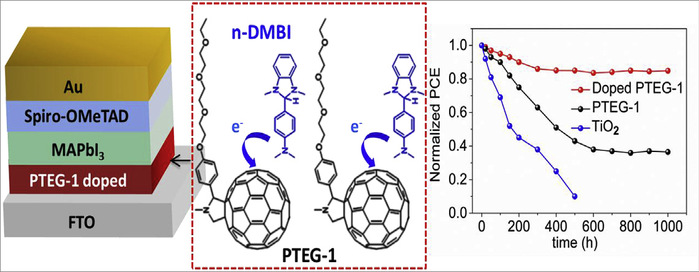
Xiaotao Liua,1, Pengwei Lib,1, Yiqiang Zhanga,∗,1, Xiaotian Hub, Yanyan Duana, Fengyu Lib,c, Dan Lic, Guosheng Shaoa, Yanlin Songb,∗∗

Highlights:
• Deposited doped PTEG-1 is not required thermally annealing
• The doped PTEG-1 self-assembled into stable layered structure.
• CH3NH3PbI3-based n-i-p cells exhibit a PCE of 18.5%.
• Devices sustain 85% of initial efficiency after 1000 h under 60 °C.
Abstract: Perovskite solar cells are promising photovoltaic devices with high efficiency beyond 23%, but thermal instability is one of the key obstacles for the commercialization. To prolong thermal stability, (4-(1,3-dimethyl-2,3-dihydro-1H-benzoimidazol-2-yl) phenyl)dimethylamine is doped into a state-of-the-art fullerene derivative with a hydrophilic triethylene glycol type side chain as electron transport layer in planar perovskite cells with low temperature process (< 100 °C). The addition of dopant in electron transport layer results in stable layered structure. We observe that the increase of electron transport layer conductivity and optimized reduction of work function facilitate charge extraction and improve the energy level alignment. As a result, CH3NH3PbI3-based n-ip perovskite cells with doped electron transport layer exhibit a hysteresis-free power conversion efficiency of 18.5%, outperforming the ones based on pristine electron transport layer (16.2%) or the other fullerene derivatives. Strikingly, the corresponding unsealed devices in air show long-term thermal stability. Devices sustain 85% of their initial efficiency after 1000 h storage under 60 °C. Our work bodes well for the dawn of commercialization of perovskite devices, providing the chance for the exploration of such high-efficiency devices with long-term thermal stability on flexible substrates.




